Global Self-Esteem and Stress Intensity in a Group of Polish Nurses—A Mediatory Role of a Sense of Coherence
Abstract
:1. Introduction
1.1. Stress
1.2. Self-Esteem and Health
1.3. Sense of Coherence
2. Materials and Methods
2.1. Settings and Design
2.2. Research Instruments
2.2.1. Perceived Stress Scale (PSS-10)
2.2.2. Rosenberg’s Self-Esteem Scale (SES)
2.2.3. Sense of Coherence (SOC-29) Questionnaire
2.3. Statistical Analysis
3. Results
3.1. Participants
3.2. The Stress Intensity and Global Self-Esteem
3.3. The Sense of Coherence
3.4. Mediation Analysis
3.4.1. The Correlation between Global Self-Esteem and the Stress Intensity with a Mediator—A General Sense of Coherence
3.4.2. Correlation between Global Self-Esteem and the Stress Intensity with a Mediator—A Sense of Comprehensibility
3.4.3. A Correlation between the Global Self-Esteem and the Stress Intensity with a Mediator—A Sense of Manageability
3.4.4. A Correlation between Global Self-Esteem and the Stress Intensity with a Mediator—A Sense of Meaningfulness
4. Discussion
Limitations and Implications for Professional Practice
5. Conclusions
Funding
Institutional Review Board Statement
Informed Consent Statement
Data Availability Statement
Conflicts of Interest
References
- Kupcewicz, E.; Jóźwik, M. Positive orientation and strategies for coping with stress as predictors of professional burnout among Polish nurses. Int. J. Environ. Res. Public Health 2019, 16, 4264. [Google Scholar] [CrossRef] [Green Version]
- Kupcewicz, E. Jakość życia pielęgniarek a strategie radzenia sobie ze stresem doświadczanym w środowisku pracy [Quality of life of nurses and strategies for coping with stress experienced in the work environment]. Med. Ogólna Nauk. Zdrowiu 2017, 23, 62–67. [Google Scholar] [CrossRef]
- Kupcewicz, E.; Jóźwik, M. Association of burnout syndrome and global selfesteem among Polish nurses. Arch. Med. Sci. 2020, 16, 135–145. [Google Scholar] [CrossRef]
- Juczyński, Z.; Ogińska-Bulik, N. Narzędzia Pomiaru Stresu i Radzenia Sobie ze Stresem [Tools for Measuring Stress and Coping with Stress]; Pracownia Testów Psychologicznych: Warszawa, Poland, 2009. [Google Scholar]
- Rosenberg, M. Society and Adolescent Self-Image; Princeton University Press: New York, NY, USA, 1965; pp. 30–31. [Google Scholar]
- Dzwonkowska, I.; Lachowicz-Tabaczek, K.; Łaguna, M. Samoocena i Jej Pomiar [Self-Esteem and Its Measurement]; Pracownia Testów Psychologicznych: Warszawa, Poland, 2008. [Google Scholar]
- Laguna, M.; Lachowicz-Tabaczek, K.; Dzwonkowska, I. Skala Samooceny SES Morrisa Rosenberga-polska adaptacja metody [The SES Self-Assessment Scale by Morris Rosenberg-Polish adaptation of the method]. Psychol. Społeczna 2007, 2, 164–176. [Google Scholar]
- Antonovsky, A. Rozwikłanie Tajemnicy Zdrowia: Jak Radzić Sobie ze Stresem i Nie Zachorować [Unraveling the Mystery of Health: How to Deal with Stress and Not Get Sick]; Instytut Psychiatrii i Neurologii: Polska, Warszawa, 2005.
- Lazarus, R.S.; Folkman, S. Stress, Appraisal and Coping; Springer: New York, NY, USA, 1984. [Google Scholar]
- Hobfoll, S.E. Stres, Kultura i Społeczność [Stress, Culture and Community]; Gdańskie Wyd. Psychologiczne: Gdańsk, Poland, 2006. [Google Scholar]
- Goś, A.; Rzemek, C.; Śledziewska, K.; Humeniuk, E. Wybrane zasoby osobiste jako czynniki zwiększające odporność na wypalenie zawodowe u pracowników zawodów medycznych [Selected personal resources as factors increasing resistance to burnout in medical professions]. Med. Ogólna Nauk. Zdrowiu 2016, 22, 181–186. (In Polish) [Google Scholar] [CrossRef]
- Yu, F.; Raphael, D.; Mackay, L.; Smith, M.; King, A. Personal and work-related factors associated with nurse resilience: A systematic review. Int. J. Nurs. Stud. 2019, 93, 129–140. [Google Scholar] [CrossRef] [PubMed]
- Martos Martínez, Á.; Molero Jurado, M.D.M.; Pérez-Fuentes, M.D.C.; Barragán Martín, A.B.; Simón Márquez, M.; Gázquez Linares, J.J. Role of Personality and Positive and Negative Affects in Coping Strategies of Nurses: A Cross-Sectional Study. Front. Psychol. 2021, 12, 682153. [Google Scholar] [CrossRef]
- Ryff, C.D. Psychological well-being revisited: Advances in Science and Practice. Psychother. Psychosoma. 2014, 83, 10–28. [Google Scholar] [CrossRef] [PubMed] [Green Version]
- Ryff, C.D. Eudaimonic well-being, inequality, and health: Recent findings and future directions. Int. Rev. Econ. 2017, 64, 159–178. [Google Scholar] [CrossRef]
- van Mol, M.; de Veer, M.; de Pagter, A.; Kouwenhoven-Pasmooij, T.A.; Hoogendijk, W.; Busschbach, J.; Oude Hengel, K.; Kranenburg, L. Vitality, resilience and the need for support among hospital employees during the COVID-19 pandemic: Study protocol of a mixed-methods study. BMJ 2021, 11, e049090. [Google Scholar] [CrossRef]
- Lin, Q.; Zheng, Y. Nurses’ Emotional Stress Levels When Caring for COVID-19 Patients in an Intensive Care Unit. Altern. Ther. Health Med. 2021, 27, 46–50. [Google Scholar] [PubMed]
- Gori, A.; Topino, E.; Di Fabio, A. The protective role of life satisfaction, coping strategies and defense mechanisms on perceived stress due to COVID-19 emergency: A chained mediation model. PLoS ONE 2020, 15, e0242402. [Google Scholar] [CrossRef]
- Johnson, A.R.; Jayappa, R.; James, M.; Kulnu, A.; Kovayil, R.; Joseph, B. Do Low Self-Esteem and High Stress Lead to Burnout Among Health-Care Workers? Evidence From a Tertiary Hospital in Bangalore, India. Saf. Health Work 2020, 11, 347–352. [Google Scholar] [CrossRef] [PubMed]
- Li, X.; Guan, L.; Chang, H.; Zhang, B. Core self-evaluation and burnout among Nurses: The mediating role of coping styles. PLoS ONE 2014, 26, e115799. [Google Scholar] [CrossRef] [PubMed]
- Santos, S.; Macedo, F.; Silva, L.; Resck, Z.; Nogueira, D.A.; Terra, F.S. Work accidents and self-esteem of nursing professional in hospital settings. Rev. Lat. Am. Enferm. 2017, 25, e2872. [Google Scholar] [CrossRef] [PubMed]
- Radhakrishnan, R.V.; Jain, M.; Mohanty, C.R.; Jacob, J.; Shetty, A.P.; Stephen, S.; Vijay, V.R.; Issac, A. The perceived social stigma, self-esteem, and its determinants among the health care professionals working in India during COVID 19 pandemic. Med. J. Armed. Forces India 2021, 77 (Suppl. 2), 450–458. [Google Scholar] [CrossRef]
- Stock, E. Exploring salutogenesis as a concept of health and wellbeing in nurses who thrive professionally. Br. J. Nurs. 2017, 26, 238–241. [Google Scholar] [CrossRef] [PubMed] [Green Version]
- Dziubak, M.; Motyka, M. Zmiany poczucia koherencji w toku studiów pielęgniarskich [Changes in the sense of coherence in the course of nursing studies]. Probl. Pielęg. 2018, 26, 109–115. [Google Scholar]
- Masanotti, G.M.; Paolucci, S.; Abbafati, E.; Serratore, C.; Caricato, M. Sense of Coherence in Nurses: A Systematic Review. Int. J. Environ. Res. Public Health 2020, 17, 1861. [Google Scholar] [CrossRef] [Green Version]
- Hochwalder, J. Test of antonovsky’s postulate: High sense of coherence helps people avoid negative life events 1. Psychol. Rep. 2015, 116, 363–376. [Google Scholar] [CrossRef] [PubMed]
- Schäfer, S.K.; Lass-hennemann, J.; Groesdonk, H.; Volk, T.; Michael, T. Mental Health in Anesthesiology and ICU Staff: Sense of Coherence Matters. Front. Psychiatry 2018, 9, 440. [Google Scholar] [CrossRef]
- Betke, K.; Basińska, M.A.; Andruszkiewicz, A. Sense of coherence and strategies for coping with stress among nurses. BMC Nurs. 2021, 20, 107. [Google Scholar] [CrossRef]
- Eriksson, M.; Kerekes, N.; Brink, P.; Pennbrant, S.; Nunstedt, H. The level of sense of coherence among Swedish nursing staff. J. Adv. Nurs. 2019, 75, 2766–2772. [Google Scholar] [CrossRef]
- Vandenbroucke, J.P.; von Elm, E.; Altman, D.G.; Gøtzsche, P.C.; Mulrow, C.D.; Pocock, S.J.; Poole, C.; Schlesselman, J.J.; Egger, M.; for the STROBE Initiative. Strengthening the reporting of observational studies in epidemiology (strobe): Explanation and elaboration. Int. J. Surg. 2014, 12, 1500–1524. [Google Scholar] [CrossRef] [PubMed] [Green Version]
- Kupcewicz, E.; Drężek-Skrzeszewska, M.; Roszuk, W.; Jóźwik, M. Relationship Between Frequency and Intensity of Menopausal Symptoms and Quality of Life Among Polish Nurses. Risk Manag. Healthc Policy 2021, 14, 97–107. [Google Scholar] [CrossRef] [PubMed]
- Koniarek, J.; Dudek, B.; Makowska, Z. Kwestionariusz Orientacji Życiowej [Life Orientation Questionnaire]. Adaptacja [Kwestionariusz poczucia koherencji] The Sense of Coherence Questionnaire (SOC) A. Antonovsky’ego]. Przegl. Psychol. 1993, 36, 491–502. [Google Scholar]
- Baron, R.M.; Kenny, D.A. The moderator-mediator variable distinction in social psychological research: Conceptual, strategic, and statistical considerations. J. Pers. Soc. Psychol. 1986, 51, 1173–1182. [Google Scholar] [CrossRef]
- Sobel, M.E. Asymptotic intervals for indirect effects in structural equations models. In Sociological Methodology; Leinhart, S., Ed.; Jossey-Bass: San Francisco, CA, USA, 1982; pp. 290–312. [Google Scholar]
- Szymczak, W. Podstawy Statystyki dla Psychologów [Fundamentals of Statistics for Psychologists]; DIFIN: Warszawa, Poland, 2018. [Google Scholar]
- Kupcewicz, E.; Grochans, E.; Kaducáková, H.; Mikla, M.; Jóźwik, M. Analysis of the Relationship between Stress Intensity and Coping Strategy and the Quality of Life of Nursing Students in Poland, Spain and Slovakia. Int. J. Environ. Res. Public Health 2020, 17, 4536. [Google Scholar] [CrossRef]
- Zheng, R.; Zhou, Y.; Qiu, M.; Yan, Y.; Yue, J.; Yu, L.; Lei, X.; Tu, D.; Hu, Y. Prevalence and associated factors of depression, anxiety, and stress among Hubei pediatric nurses during COVID-19 pandemic. Compr. Psychiatry 2021, 104, 152217. [Google Scholar] [CrossRef]
- Mazza, C.; Ricci, E.; Biondi, S.; Colasanti, M.; Ferracuti, S.; Napoli, C.; Roma, P. A Nationwide Survey of Psychological Distress among Italian People during the COVID-19 Pandemic: Immediate Psychological Responses and Associated Factors. Int. J. Environ. Res. Public Health 2020, 17, 3165. [Google Scholar] [CrossRef]
- Schmitt, D.P.; Allik, J. Simultaneous administration of the Rosenberg Self-Esteem Scale in 53 nations: Exploring the universal and culture-specific features of global self-esteem. J. Pers. Soc. Psychol. 2005, 89, 623–642. [Google Scholar] [CrossRef] [PubMed] [Green Version]
- Neff, K. Self-compassion: An alternative conceptualization of a healthy attitude toward oneself. Self Identity 2003, 2, 85–101. [Google Scholar] [CrossRef] [Green Version]
- Dzwonkowska, I. Współczucie Wobec Samego Siebie Jako Moderator Wpływu Samooceny Globalnej na Afektywne Funkcjonowanie Ludzi [Self-Compassion as a Moderator of the Impact of Global Self-Esteem on the Human Affective Functioning]; Psychologia Społeczna, Polskie Stowarzyszenie Psychologii Społecznej: Warszawa, Poland, 2011; Volume 6, pp. 67–80. [Google Scholar]
- Duran, S.; Önel, Ç.; Güloğlu, P.; Ümit, S. The relationship between self-esteem and psychological distress in critical care nurses. Nurs. Crit. Care 2021, 26, 517–522. [Google Scholar] [CrossRef] [PubMed]
- Dimunová, L.; Bérešová, A.; Raková, J.; Rónyová, I.; Fertaľová, T. The relationship between self-esteem of nurses and their choice of strategies to cope with workload burden. Cent. Eur. J. Nurs. Midw. 2020, 11, 130–135. [Google Scholar] [CrossRef]
- Kretowicz, K.; Bieniaszewski, L. Determinants of sense of coherence among managerial nursing Staff. Ann. Agric. Environ. Med. 2015, 22, 713–717. [Google Scholar] [CrossRef]
- Kocięcka, A.; Andruszkiewicz, A.; Wrońska, I. Poczucie koherencji a stan zdrowia pielęgniarek czynnych zawodowo [A sense of coherence and the health of professionally active nurses]. Probl. Pielęg. 2010, 18, 139–144. [Google Scholar]
- Malagon-Aguilera, M.C.; Suñer-Soler, R.; Bonmatí-Tomas, A.; Bosch-Farré, C.; Gelabert-Vilella, S.; Juvinyà-Canal, D. Relationship between sense of coherence, health and work engagement among nurses. J. Nurs. Manag. 2019, 27, 1620–1630. [Google Scholar] [CrossRef]
- Ando, M.; Kawano, M. Relationships among moral distress, sense of coherence, and job satisfaction. Nurs. Ethics 2018, 25, 571–579. [Google Scholar] [CrossRef]
- Jażdżewska, N.; Kretowicz, K.; Żuralska, R. Nadzieja na sukces a poczucie koherencji w grupie zawodowej pielęgniarek [Hope and sense of coherence in the professional group of nurses]. Probl. Pielęgn. 2018, 26, 9–14. [Google Scholar]
- Hiensch, A.E.; Bolam, K.A.; Mijwel, S.; May, A.M.; Wengström, Y. Sense of coherence and its relationship to participation, cancer-related fatigue, symptom burden, and quality of life in women with breast cancer participating in the OptiTrain exercise trial. Support. Care Cancer 2020, 28, 5371–5379. [Google Scholar] [CrossRef] [Green Version]
- Zamanian, H.; Amini-Tehrani, M.; Mahdavi Adeli, A.; Daryaafzoon, M.; Arsalani, M.; Enzevaei, A.; Farjami, M. Sense of coherence and coping strategies: How they influence quality of life in Iranian women with breast cancer. Nurs. Open 2021, 8, 1731–1740. [Google Scholar] [CrossRef] [PubMed]
- Colomer-Pérez, N.; Chover-Sierra, E.; Gea-Caballero, V.; Paredes-Carbonell, J.J. Health Assets, Vocation and Zest for Healthcare Work. A Salutogenic Approach to Active Coping among Certified Nursing Assistant Students. Int. J. Environ. Res. Public Health 2020, 17, 3586. [Google Scholar] [CrossRef] [PubMed]
- Allan, B.A.; Douglass, R.P.; Duffy, R.D.; McCarty, R.J. Meaningful Work as a Moderator of the Relation Between Work Stress and Meaning in Life. J. Career Assess. 2016, 24, 429–440. [Google Scholar] [CrossRef]
- Quick, J.C.; Henderson, D.F. Occupational Stress: Preventing Suffering, Enhancing Wellbeing. Int. J. Environ. Res. Public Health 2016, 13, 459. [Google Scholar] [CrossRef] [Green Version]
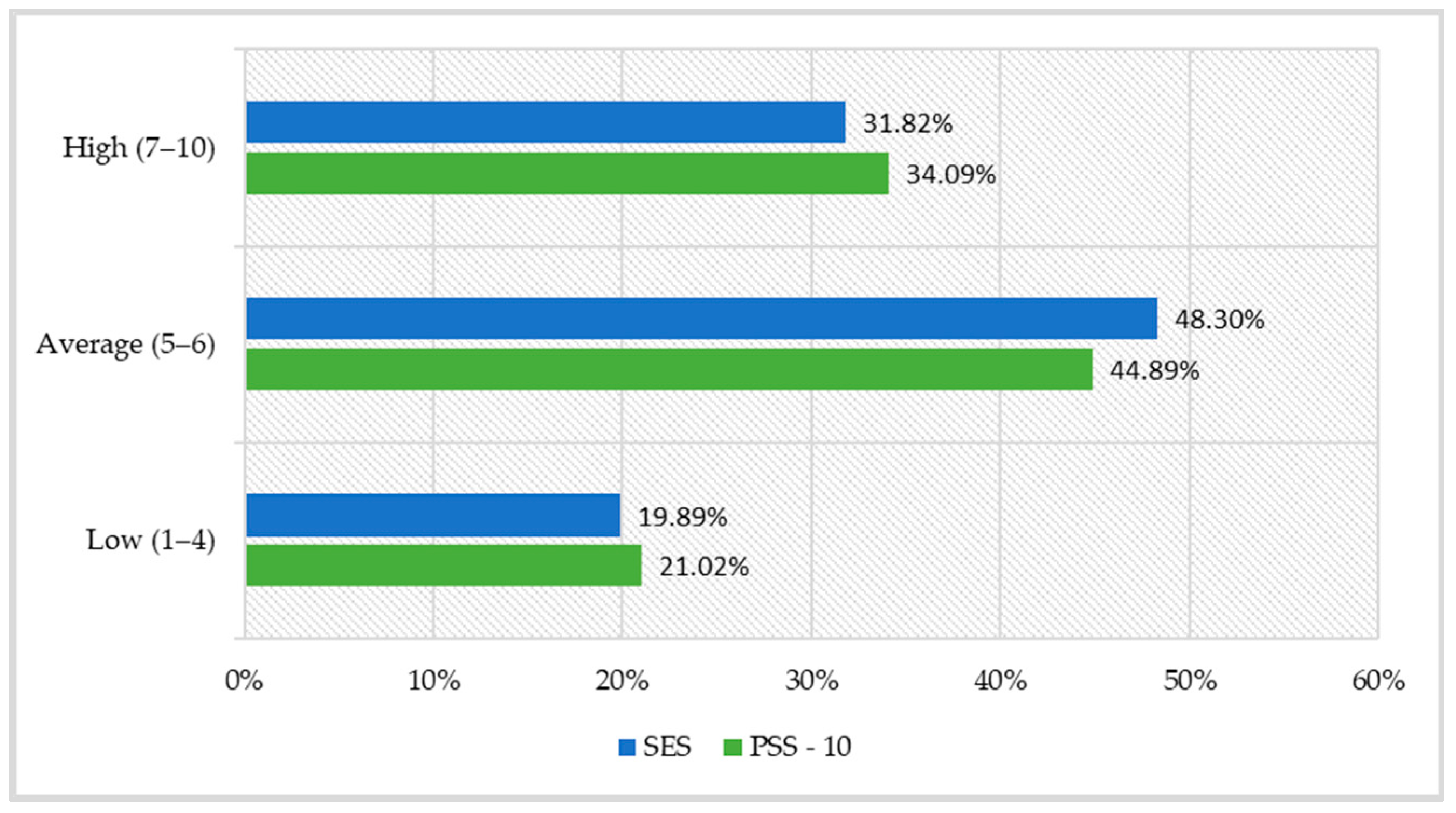
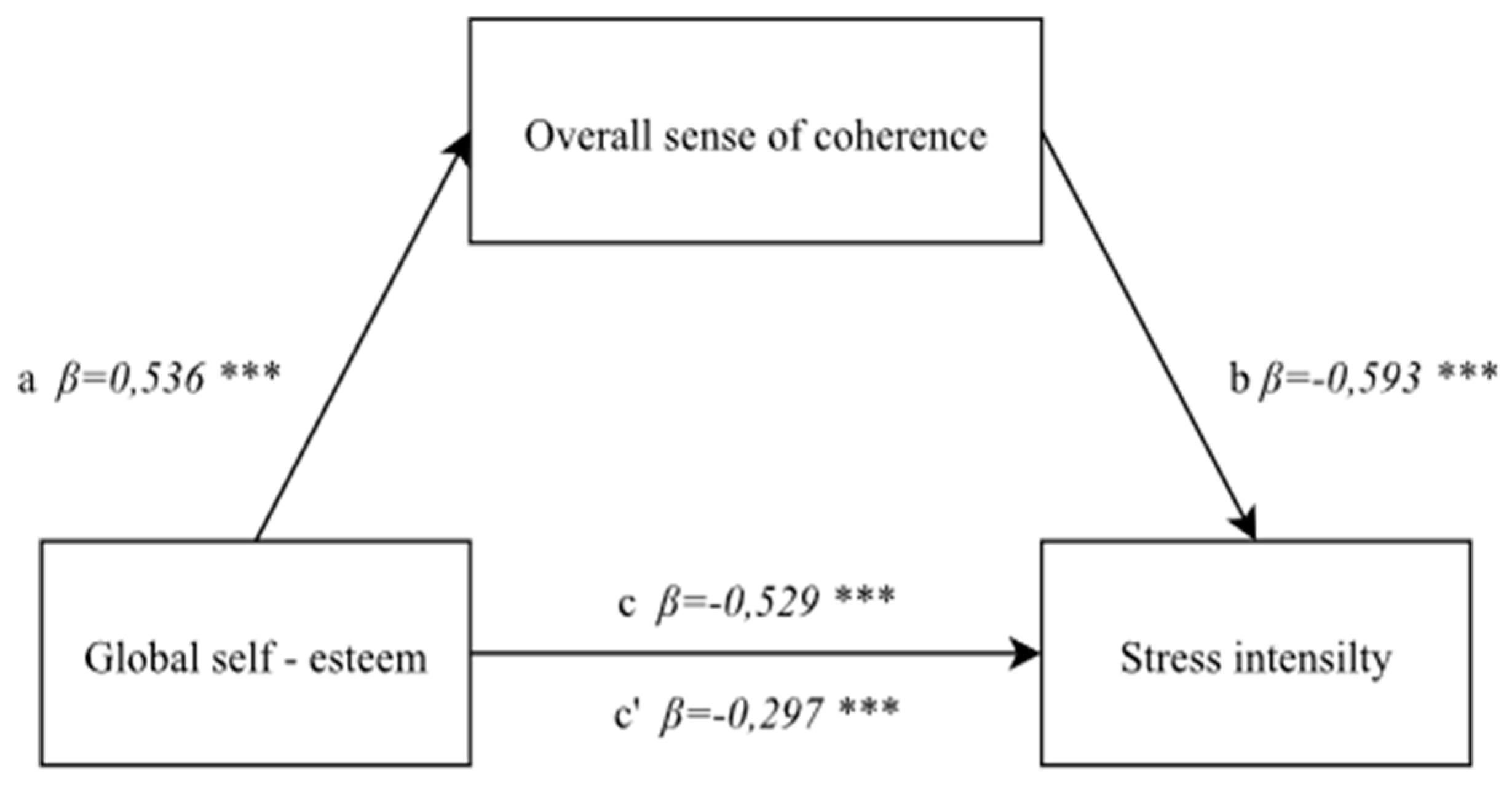
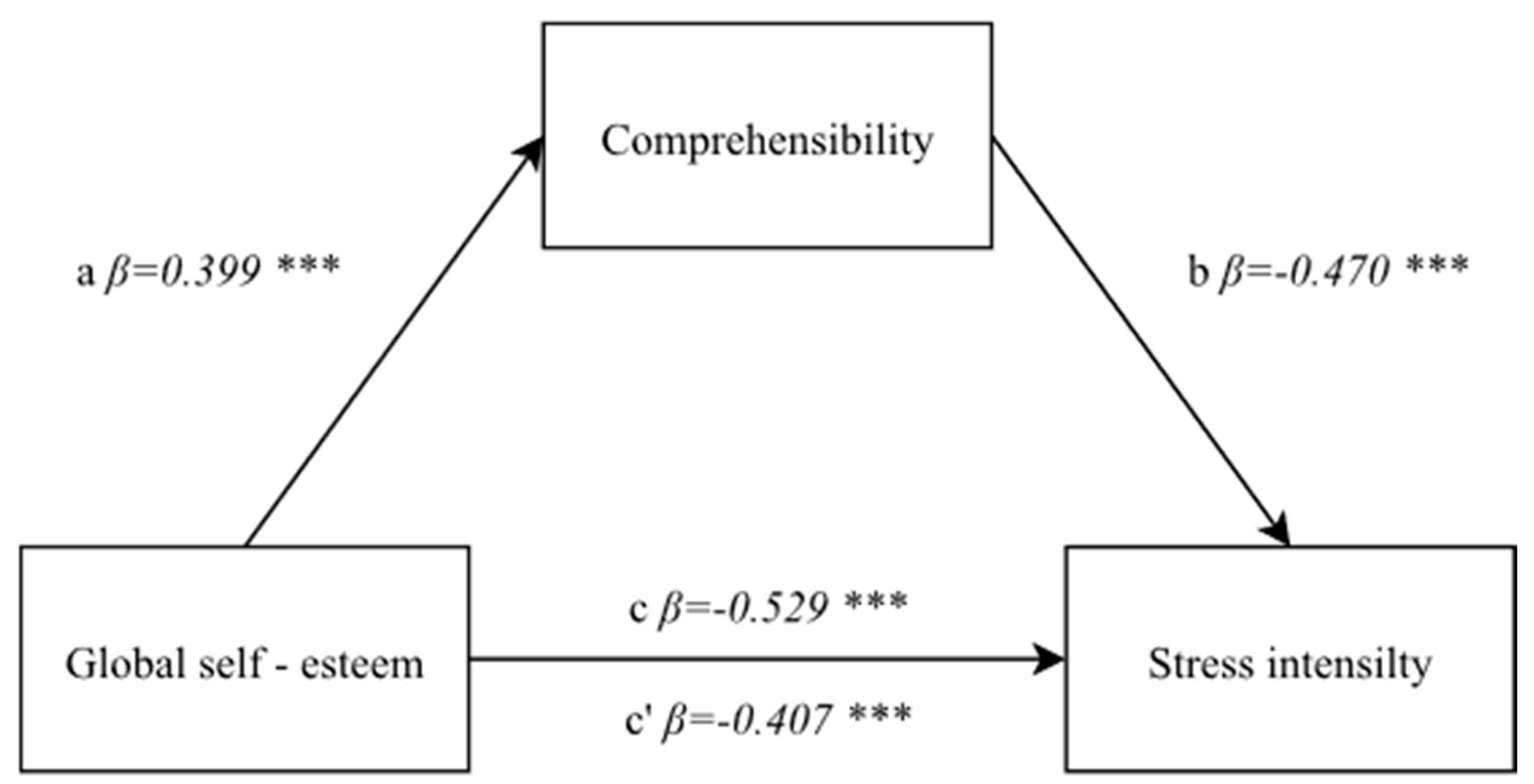
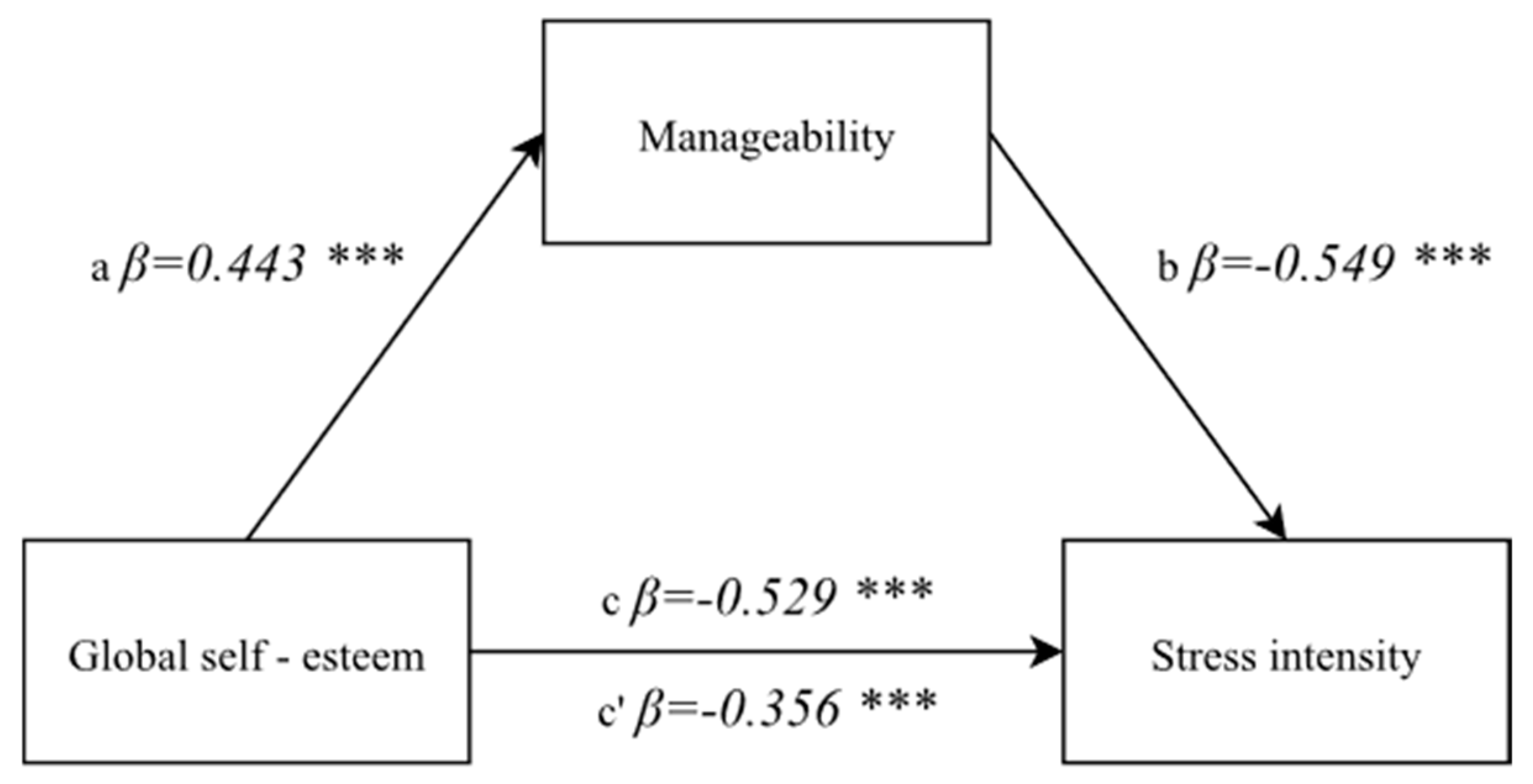
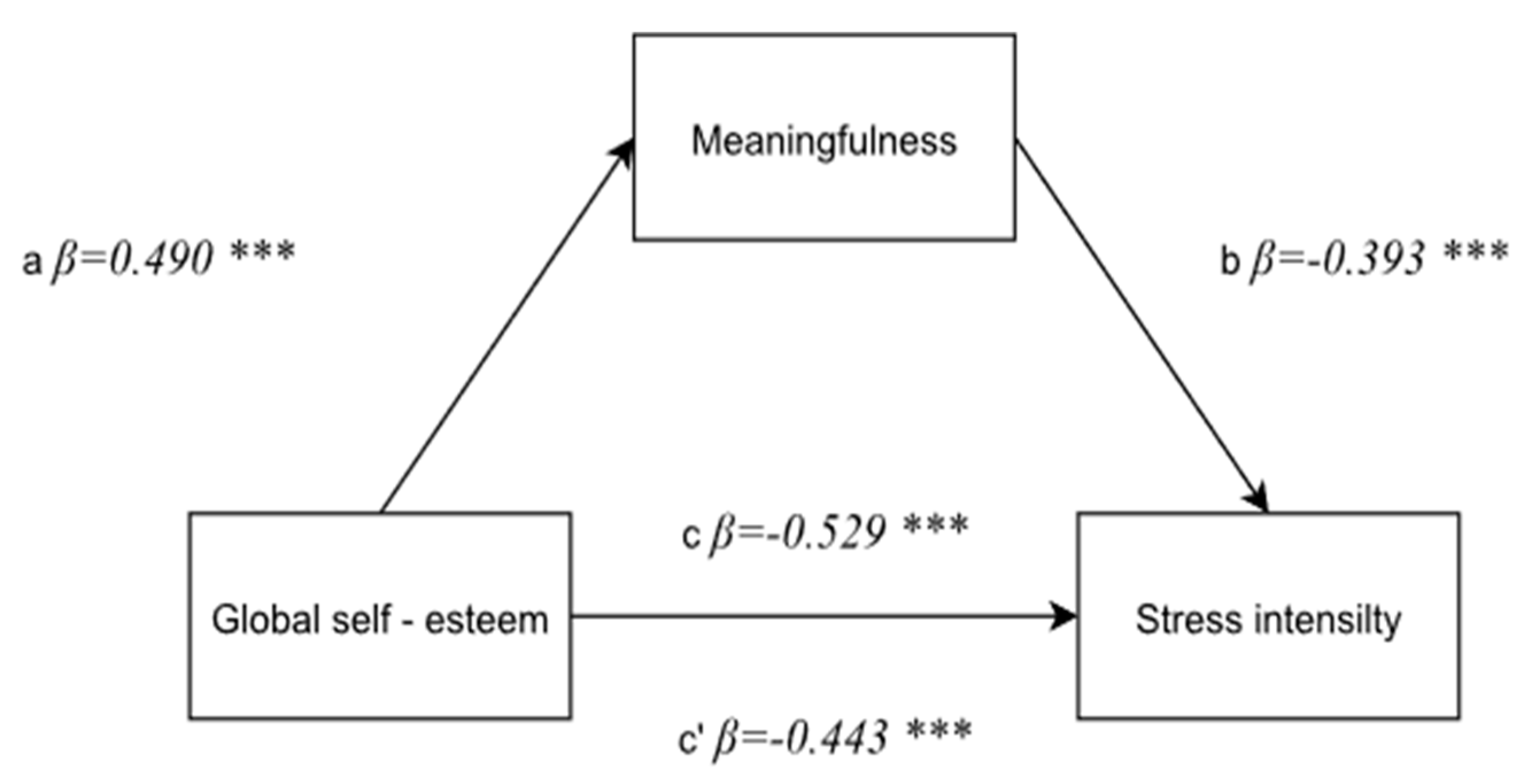
| Variables | Frequency (n) | Percentage (%) | |
|---|---|---|---|
| Education | secondary | 98 | 55.68 |
| university | 78 | 44.32 | |
| Place of residence | village | 23 | 13.07 |
| town | 153 | 86.93 | |
| Marital status | single | 11 | 6.25 |
| married/in a civil relationship | 143 | 81.25 | |
| widow | 4 | 2.27 | |
| divorced/separated | 18 | 10.23 | |
| Financial status | good/very good | 71 | 40.34 |
| satisfactory | 81 | 46.02 | |
| poor/very poor | 24 | 13.64 | |
| Variables | n = 176 | |||
|---|---|---|---|---|
| M | 95% Cl | Min.–Max. | SD | |
| PSS-10 | 17.4 | 16.6–18.2 | 0–33.0 | 5.3 |
| SES | 30.9 | 30.3–31.6 | 19.0–40.0 | 4.2 |
| Variables | n = 176 | ||||
|---|---|---|---|---|---|
| M | 95% Cl | Min.–Max. | SD | ||
| SOC-29 (7–203 points) | 130.5 | 127.5–133.4 | 71.0–188.0 | 19.8 | |
| SOC-29 components | Comprehensibility (7–77 points) | 47.0 | 45.4–48.6 | 27.0–67.0 | 10.6 |
| Manageability (7–70 points) | 47.5 | 46.4–48.7 | 9.0–67.0 | 7.8 | |
| Meaningfulness (7–56 points) | 36.0 | 35.1–35.8 | 18.0–50.0 | 5.5 | |
Publisher’s Note: MDPI stays neutral with regard to jurisdictional claims in published maps and institutional affiliations. |
© 2022 by the author. Licensee MDPI, Basel, Switzerland. This article is an open access article distributed under the terms and conditions of the Creative Commons Attribution (CC BY) license (https://creativecommons.org/licenses/by/4.0/).
Share and Cite
Kupcewicz, E. Global Self-Esteem and Stress Intensity in a Group of Polish Nurses—A Mediatory Role of a Sense of Coherence. Int. J. Environ. Res. Public Health 2022, 19, 975. https://doi.org/10.3390/ijerph19020975
Kupcewicz E. Global Self-Esteem and Stress Intensity in a Group of Polish Nurses—A Mediatory Role of a Sense of Coherence. International Journal of Environmental Research and Public Health. 2022; 19(2):975. https://doi.org/10.3390/ijerph19020975
Chicago/Turabian StyleKupcewicz, Ewa. 2022. "Global Self-Esteem and Stress Intensity in a Group of Polish Nurses—A Mediatory Role of a Sense of Coherence" International Journal of Environmental Research and Public Health 19, no. 2: 975. https://doi.org/10.3390/ijerph19020975
APA StyleKupcewicz, E. (2022). Global Self-Esteem and Stress Intensity in a Group of Polish Nurses—A Mediatory Role of a Sense of Coherence. International Journal of Environmental Research and Public Health, 19(2), 975. https://doi.org/10.3390/ijerph19020975






